Basic properties of gold
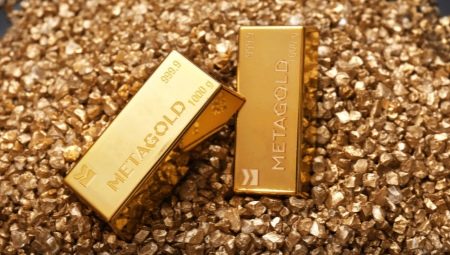
Due to its chemical and physical properties, gold belongs to a small group of the most valuable and rare metals found in nature. Humanity appreciates this precious metal for its beauty and ability to maintain its bright and shiny appearance in jewelry and coins made from it. It is also used in some industries. For many centuries, gold items have been a luxury item and have never lost their value, emphasizing the high level of solvency of their owner or the country that owns gold and foreign exchange reserves. You can often hear that it is gold that is the international payment system, which has weight and significance in the territory of any world state.
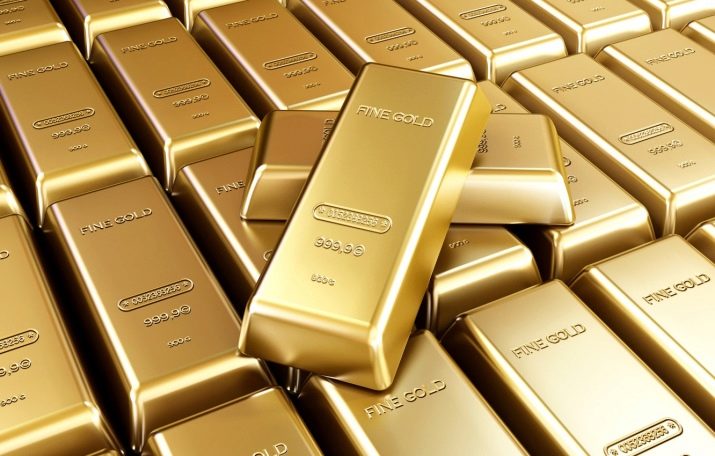
Physical properties
In appearance, this mineral looks like small pieces of metal of irregular round shape, straw-yellow color. Basic physical properties of gold:
- metal melting occurs at a temperature equal to 1063 ° C;
- the density of the substance is 19.33 g / cu. cm;
- hardness indicators, determined by the Mohs scale, can be from 2.5 to 3;
- it is possible to bring the metal to the highest boiling point at t = 2948 ° С;
- the level of specific thermal conductivity at t = 0 ° C is equal to 311.5 W / mK;
- the strength of the metal after annealing is from 100 to 140 MPa.
According to the structure of its crystal lattice, gold is a rather soft substance, and various impurities, called ligatures, are added to the metal to impart hardness.
After adding other components in the form of a ligature, the overall melting temperature of the gold alloy decreases, while the physical and mechanical properties of the metal itself change.
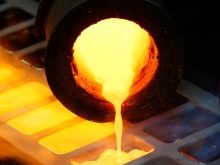
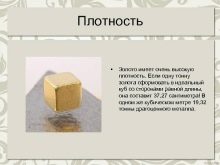
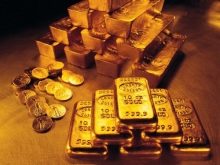
This valuable natural mineral has other unique physical properties.
- High level of plasticity. From 1 gram of gold, if desired, you can draw out a wire up to 2-2.6 meters long or roll out the metal in the form of a flat sheet of foil 1 micron thick. Due to the natural softness of gold, it was noticed that, within 1 year, coins in circulation could lose up to 0.1% of their original weight when cast.
The ductility property of gold allows it to be used in modern electronics.
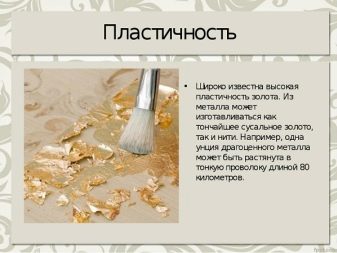
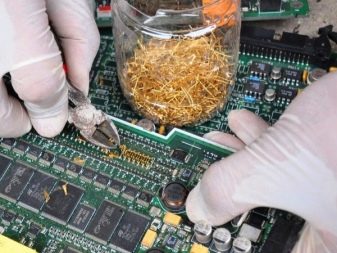
- High reflectivity. The finished precious alloy has the ability to be easily polished to a bright mirror finish. Thin sheets of rolled material are used for gilding. This is even used in astronautics - the thinnest layers of gold are applied to the helmets of astronauts and the surfaces of outer space equipment to protect them from the harmful effects of infrared radiation, which manifests itself in outer space.
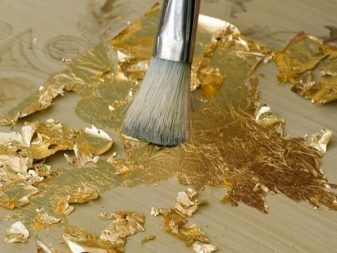

- Spray capability. The precious mineral tends to disintegrate into tiny fractions equal in size to the length of light waves. This ability allows this material to be sprayed. For example, it is known that in water bodies and rivers there is a dispersion of gold, which cannot be seen visually, but can be determined using special instruments. The surface, covered with the thinnest gold layer, is capable of letting in the rays of the sun without heating up.
This ability is used for the purpose of tinting glass in southern latitudes, where there is a need to protect the premises from overheating.
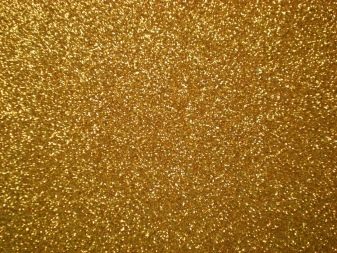

- Good malleability. Gold has softness and the ability to take the desired shape, which is one of its most valuable qualities. For example, from 1 gram of gold, you can make a sheet of thin foil, the area of which will be at least 1 square meter. m. This property is used to make gilding in the form of the finest gold leaf, which goes to cover church domes and icons, is used to decorate interiors, and is used to create art objects.
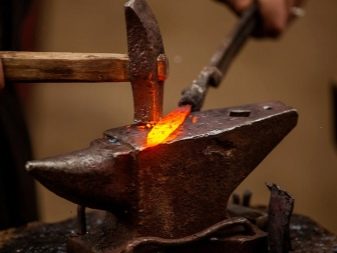
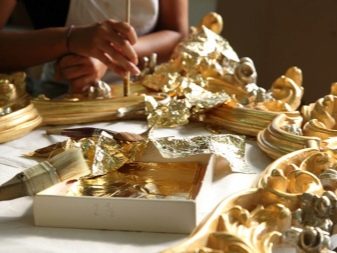
- High level of electrical conductivity. With resistance to oxidative processes, the precious mineral has good electrical conductivity. This property of metal makes it possible to use it for the manufacture of resistances in electronic circuits of many modern devices: telephones, televisions, computers, multimedia players, in radio engineering and other similar devices.
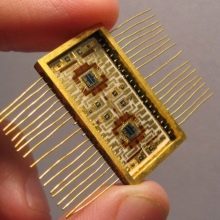
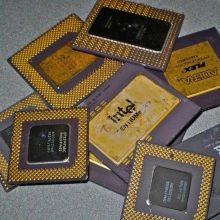
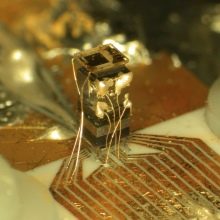
It is known that the precious metal is completely odorless, and also this material does not have the ability to be magnetized. In addition, it has been scientifically proven that gold as an element is included in at least 15 minerals mined in the earth's interior. In most of the mined rocks in this number, gold is included in a pulverized composition found at the atomic level.
Arsenide and sulfide deposits are often rich in gold nuggets.
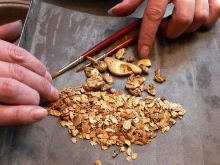

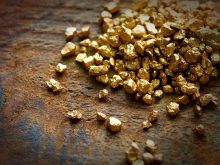
Chemical characteristics
The metal called gold (aurum) has the designation - Au, which literally means "sunny" or "yellow". In Mendeleev's system, the metal is assigned to group 1, it is assigned an atomic number of 79. The chemical crystal lattice of Au has a cubic structure.
The metal has special chemical properties.
- Relative inertia. Gold does not change its properties upon contact with sulfur and oxygen, does not interact with nitrogen, carbon, hydrogen and phosphorus. Gold does not react to many alkalis and acids.
- The valence of this chemical element manifests itself as + I or + III.
- At t = 20 ° C, the metal enters into a chemical reaction with aqueous solutions of chlorine and bromine. And aqueous-alcoholic solutions of iodine, reacting with gold 585, leave areas of dark spots on it, which does not happen if iodine is dropped on 750 gold.
- The color spectrum of a metal depends on what particle size it consists of. The smallest gold particles can have a greenish-gray hue. According to geological prospecting data, there is only one for every 20 mines, where gold is mined in the form of yellow nuggets.
The exact chemical formula of a gold alloy depends on what additional components are included in its composition in the form of a master alloy.



Features of the properties of alloys
If a natural gold nugget is melted, then in a liquid state it will look like a substance that has a pale greenish-gray tint, and this shade is also inherent in vapors that rise from the hot molten metal. One has only to heat the substance to a temperature exceeding 1064 ° C, that is, to increase the melting index of the metal by at least 1 ° C, as the vapor of the gold alloy will begin to evaporate into the atmosphere. And the higher the melting point of a substance, the higher its volatility will be. If the components of mercury, arsenic, as well as antimony or tellurium are added to the alloy, evaporation from the surface of the gold alloy will increase even more, since these components will form the so-called volatile compounds.
Jewelers working with various gold alloys have noticed that ligature impurities affect the chemical, physical and external properties of the material resulting from the remelting of gold.
Let us consider in more detail how the properties of a precious mineral change when combined with different substances.
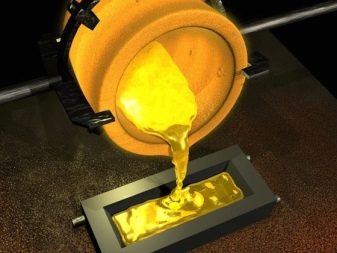
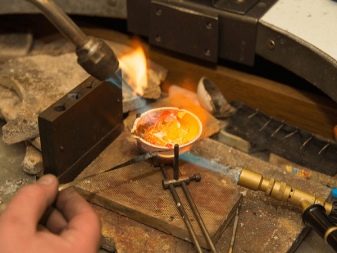
With silver
In combination with silver, the noble yellow metal lowers its melting point and also changes its natural original greenish yellow color to steel silvery shades. This combination has its positive and negative sides. Despite external visual changes, the strength of the finished remelted material only increases when combined with silver. But in the course of practical research, it was found that in a precious alloy with such a composition, such important qualities as malleability and ductility are somewhat reduced. However, this does not mean at all that Au and Ag alloys are not used - on the contrary, this is a fairly common combination that jewelers quite often use in their work.
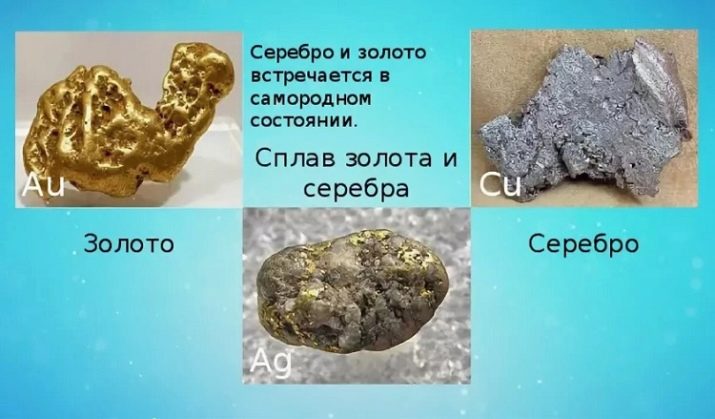
With copper
Changes in the physical properties of the finished precious alloy will occur if copper is added as a master alloy to it. This metal significantly increases the strength of the gold alloy, while maintaining the ductility of the resulting material and its good ductility with such a combination of metals.
If in the composition of the precious alloy of gold copper is present from 14.5% or more, then the finished products will have a pronounced reddish tint - such gold is usually called "pure gold". But in this case it was not without drawbacks - using a copper alloy, the resulting material loses its anticorrosive properties, which is due to the increased ability of copper to form oxidative reactions with oxygen. Contacting with a humid environment and even simply with air, over time, a product made of such an alloy will surely darken, while losing its original bright colors and shine.
Since copper has a low cost, then the alloy from it will not be too expensive in price, which is reflected in the cost of the finished product - it is the cheapest. During the Soviet era, 583 samples were produced for the population, and only in 1995 the 585 sample was introduced into production, which contained 0.2% less copper than the previous analogue, but the gold content increased by the same 0.2%. which immediately led to an increase in the price of gold items.
Currently, 583 gold alloy has been abandoned, and only 585 are used.
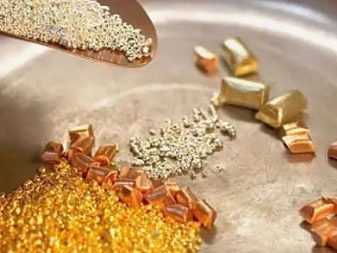

With nickel
This natural metal is used by jewelers in order to cleanse the gold alloy from natural reddishness, and especially often such a ligature is used in the manufacture of especially valuable white gold.
When combined in a precious alloy of Au and Ni, the strength of the finished precious material increases significantly. Products made of such a noble alloy have a steel color with a subtle pale straw tint. To completely eliminate this weakly manifested yellowness, the surface of the finished jewelry is covered with a thin layer of another metal - rhodium. This is done not only for beauty, but also to reduce the allergenicity of precious products.
The fact is that nickel metal is known to have the ability to cause allergic reactions on the skin... In 8 out of 10 people, these manifestations will certainly make themselves felt when wearing jewelry. Therefore, brooches, cufflinks, pendant pendants, key rings are most often made from alloys where nickel was used as a ligature, in a word, something that has little contact with human skin during prolonged contact. Over time, the thin rhodium plating on jewelry wears off, and about once every 6 or 7 years it will need to be renewed in a jewelry workshop. After carrying out such restoration work, the jewelry will again look like new, gleaming with steel bluish-silver overflows.
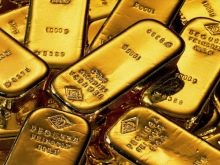
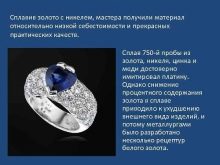
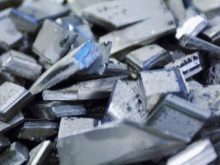
With palladium
A chemical element called palladium, according to chemists, is a by-product from the processing of precious metals. This element was obtained by combining together platinum, mercury cyanide and aqua regia (its composition: 3 parts of nitric + 1 part of hydrochloric acid). Thus, the discovery of this metal was made when Pd, Au, Pt and Ag were already discovered. In a normal temperature environment, fluorine does not affect palladium, hydrochloric acid and even aqua regia do not. This metal is absolutely not prone to oxidation when it comes into contact with oxygen, it has a very strong structure, and does not show scratches, cracks or chips, and besides, it is well susceptible to any mechanical processing and welding.
By adding the metal palladium as a ligature component to the gold alloy, it is possible to obtain white gold. Due to their unusualness and increased strength, gold items with palladium are superior in quality and cost to other gold alloys containing simpler components.
Palladium is appreciated not only in jewelry production, but also finds applications ranging from medicine to aircraft construction. At international market auctions, the price of palladium quotes sometimes even exceeds the value of gold, and jewelry made from it looks especially elegant and noble. They are in high demand among connoisseurs of white precious alloys.
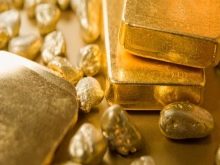
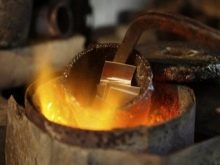
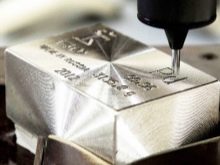
With platinum
Today, natural platinum is the most expensive of all precious metals known to mankind. In terms of its physicochemical properties, platinum has twice the density and strength than its precious counterpart, gold. Besides, platinum has the highest resistance to metal corrosion - when it comes into contact with oxygen, oxidation does not occur. Platinum in its properties is most similar to the metal palladium, the difference between them lies most of all in cost - platinum is more expensive than palladium.
When creating a noble alloy, platinum is added to pure gold, and then, after melting, a product of a sparkling silver-white color is obtained, in which there are absolutely no yellow impurities. As part of a gold alloy, platinum significantly increases its value, which also affects finished jewelry.However, this alloy enjoys a consistently high popularity and has a very good reputation among those who value the purest white alloys created from precious metals.

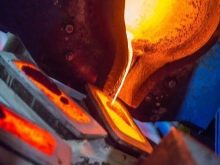
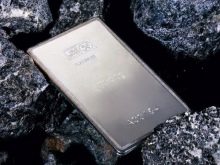
You can find out why gold is of great value below.








